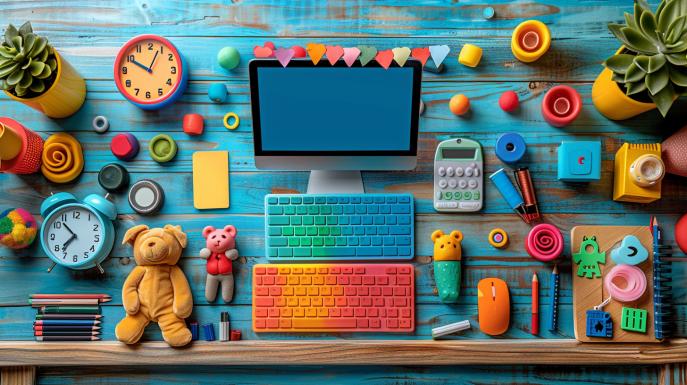Immerse yourself in the digital adventure and transform the future of your little ones with “Programming for Kids: Initial Path to Code”. In this article, we reveal the treasure map for getting started with coding for little ones, with assertive strategies and interactive resources that make learning dynamic and exciting from the first click. Discover how children's programming courses and teaching programming to young people are doors to a universe of logical and creative possibilities. Grab your kids' attention and get ready to accompany them on their first step towards the literacy of the future!
What are the first steps to introducing programming to children?
To introduce programming to children, select age-appropriate educational resources, such as Code.org It is MIT Scratch. It is crucial that parents support their children at this early stage. Visual languages like Scratch make it easier to understand basic coding concepts.
Why is teaching programming essential in child development?
Introducing programming to children is crucial; develops logical reasoning and problem-solving skills, essential in many careers. When programming, children learn to analyze complex situations and devise step-by-step solutions, which are fundamental for logical reasoning. Furthermore, when faced with bugs and code errors, they acquire resilience, learning to persist and correct failures, which significantly contributes to their ability to solve problems.
The program also encourages young people’s creativity. In the children's world, coding is more than writing lines of code; is about creating games, animations and stories, allowing children to express ideas in unique and innovative ways. This not only gives them the freedom to imagine, but also to build and see their imaginations come to life, which is incredibly rewarding and encourages creative thinking.
Ultimately, preparing children for a digital future is vital. We live in an era where digital skills are indispensable. By becoming familiar with the fundamentals of programming at an early age, children gain a significant advantage for the future, since these skills are now in demand in virtually every career. The platform Khan Academy is an excellent resource for introducing children to learning, offering programming lessons appropriate for their age and ability.
What coding tools and platforms are kid-friendly?
Kid-friendly platforms include Tynker, Blockly, and Alice. Such platforms gamify the learning experience, balancing screen interactivity with more tangible activities. For example, Tynker offers a fun way to learn programming, while Blockly simplifies building code through blocks that fit together visually.
In the field of robotics, kits like LEGO Mindstorms and VEX allow children to program their own robots, learning the fundamentals of programming and engineering in a practical and engaging way, maintaining a balance between the use of screens and interaction with the world. real.
How to make programming a fun and engaging activity for children?
Mixing educational computer games and programming teaching methods for children creates a playful approach that sparks interest. Using programming logic games, which aligns coding challenges with narrative and fascinating characters, kids absorb fundamental concepts while having fun. Engagement increases significantly when coding activities reflect the child's interests, whether through building stories, animations or solving interactive puzzles.
Programming for Kids: Early Path to Code
Introducing programming during childhood positions children for future success. Tools like MIT Scratch they simplify learning to code, allowing kids to create interactive games and stories, fostering crucial skills without the burden of complex syntax. This first contact with coding nurtures logical reasoning and problem solving while instilling creativity.
The inclusion of visual elements makes programming fundamentals easier to understand and motivates young learners, paving the way for a smooth transition to text-based programming languages like Python in the future. At the same time, the playful approach keeps the experience fun and engaging, ensuring that coding is an educational activity they seek out, rather than an obligation.
In this article, we dissect the way to get kids immersed in programming – from selecting appropriate resources to making learning fun and engaging. We highlight the importance of parental involvement, the power of visual languages like Scratch and the indelible benefits that mastering the code offers in child development. We equip parents and educators with tools and platforms like Tynker and LEGO Mindstorms and outline strategies to keep kids engaged and prepared for a digital future. Introduction to programming is more than teaching technology; it's opening doors to a world of creativity, problem solving and infinite possibilities.
FAQ
What resources are recommended for introducing programming to children?
Age-appropriate educational resources, such as Code.org and MIT's Scratch, are recommended for introducing children to programming. These platforms use visual languages to make coding concepts easier to understand.
Why is learning programming important in child development?
Learning to program is important in child development because it develops logical reasoning, problem-solving skills, and creativity. It also prepares children for a digital future and gives them a significant advantage in future careers.
Which Coding Platforms Are Kid-Friendly?
Platforms like Tynker, Blockly, Alice, LEGO Mindstorms, and VEX are kid-friendly. These tools gamify learning and provide a fun, interactive way to learn the fundamentals of programming and engineering.
How to make learning programming fun for kids?
To make learning to program fun for children, it is helpful to mix educational computer games with teaching methods that reflect the child's interests. Engaging children with fascinating narratives and characters in coding challenges can increase interest and enjoyment in learning.
How can children benefit from learning early programming?
Children can benefit from early programming learning by developing logical reasoning, problem-solving skills, and creativity. Using tools like MIT's Scratch allows you to create interactive games and stories, simplifying learning and motivating young learners.


